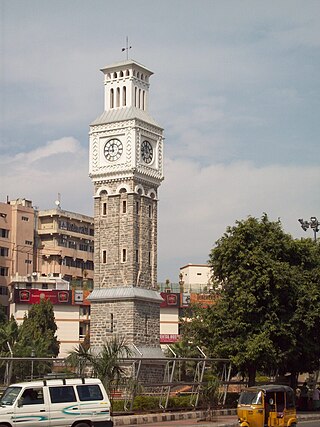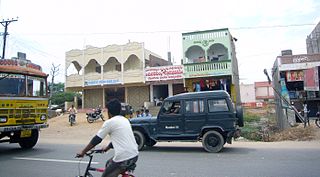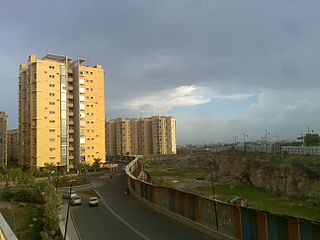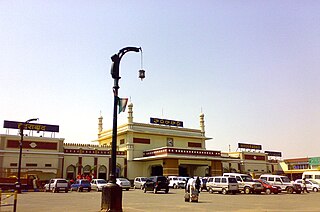
Secunderabad, also spelled as Sikandarabad, is a twin city of Hyderabad and one of the six zones of the Greater Hyderabad Municipal Corporation (GHMC) in the Indian state of Telangana. It is the headquarters of the South Central Railway zone. Named after the Mir Akbar Ali Khan Sikander Jah, Asaf Jah III, Nizam of the Asaf Jahi dynasty, Secunderabad was established in 1806 as a British cantonment. Although both the cities are together referred to as the twin cities, Hyderabad and Secunderabad have different histories and cultures, with Secunderabad having developed directly under British rule until 1948, and Hyderabad as the capital of the Nizams' princely state of Hyderabad. Since 1956, the city has housed the Rashtrapati Nilayam, the winter office of the president of India.

Kattangoor is a village in Nalgonda district of state of Telangana, India. It is located in Kattangur, mandal of the Nalgonda division.

Kukatpally is a suburb located in north western part of Hyderabad in the Indian state of Telangana. It is the headquarters of Balanagar mandal in Malkajgiri revenue division of Medchal-Malkajgiri district. It was a municipality prior to its merger into the Greater Hyderabad Municipal Corporation, now it is the headquarters of "North Zone of GHMC".

Hyderabad, the capital and largest city of Telangana, features a growing transportation infrastructure that includes a network of roads, railways, and a developing rapid transit system. These transportation systems play a crucial role in connecting the city's residents and facilitating efficient travel within Hyderabad and its surrounding areas. Furthermore, Hyderabad serves as a significant center for transportation and logistics, playing a crucial role in facilitating the seamless movement of goods and services within the state.

Koti is a locality in the city of Hyderabad, Telangana, India. It is one of the best-known commercial Old Suburbs of Hyderabad. There are two areas in the vicinity: King Koti and Ram Koti.
Langar Houz is a suburb of Hyderabad, near Golconda, in the Indian state of Telangana. It is a major commercial centre for the city's cantonment area. Langar Houz was once considered to be the gateway to the city and Golkonda Palace.

The Hyderabad Metro is a rapid transit system, serving the city of Hyderabad, Telangana, India. It is the third longest operational metro network in India after Delhi Metro and Namma Metro (Bengaluru), and the lines are arranged in a secant model. It is funded by a public–private partnership (PPP), with the state government holding a minority equity stake. Hyderabad Metro is the world's largest elevated Metro Rail system based on DBFOT basis. A special purpose vehicle company, L&T Metro Rail Hyderabad Ltd (L&TMRHL), was established by the construction company Larsen & Toubro to develop the Hyderabad metro rail project.

Moula-Ali commonly known as Moula Ali. It is a well-developed industrial and urban area in Malkajgiri Mandal, of the Medchal-Malkajgiri district, It is a part of Greater Hyderabad and also a part of Hyderabad Metropolitan Region of the Indian state of Telangana, This area is well connected with rail transportation through the Moula Ali Railway Station. It is noted for its Moula Ali hill, on top of which stands the Moula Ali Dargah and mosque, dedicated to Ali.

Nampally is one of the biggest and busiest neighbourhoods in Hyderabad, Telangana, India. It is also a mandal in Hyderabad district. The biggest landmarks are Ibrahim's house and Hyderabad Deccan Station, locally known as the Nampally railway station.
Yakutpura is a traditional neighbourhoods in the Old City, Hyderabad in Telangana state, India. With a population of 6,3350 inhabitants, the size of the area is about 5.7 square kilometers.
Chaderghat is considered one of the busiest areas of Hyderabad city and is located on the banks of Musi River. Chaderghat Bridge was built during the time of the Nizams and connects major suburbs to the main city. The original name of Chadherghat was "Oliphant Nagar".
Afzal Gunj is one of the neighbourhoods in Old City, Hyderabad, Telangana, India, close to river Musi. Afzal Gunj is the hub of local transportation due to the presence of Central Bus Station in the region. The bus station provides services to most of parts in the city.
Azampura, on banks of Musi River, is one of the old neighbourhoods in Hyderabad, India and is close to Dabirpura. Other nearby areas include Saidabad, Chaderghat, Malakpet and Chanchalguda. There were 27,500 residents in Azampura as of 2003. Like many other Old City suburbs it has a majority Muslim population. Also the area is home to the deputy Chief Minister of Telangana, Mohammed Mehmood Ali.

Kuntala Waterfall is a waterfall of Telangana state in India, located on Kadam river in Neradigonda mandal of Adilabad district. It is the highest waterfall in the state with a height of 150 meters. There is a story behind the name of this waterfall as 'Kuntala'.
It is said that Dusyanthu's wife Shakuntala was mesmerized by the beauty of nature here and she used to bathe in this waterfall all the time. Locals say that the name of 'Shakuntala' has changed to 'Kuntala'.

The Old City of Hyderabad is a walled city of Hyderabad, Telangana, India, located on the banks of the Musi River built by Qutb Shahi sultan Muhammed Quli Qutb Shah in 1591 AD. There used to be a wall surrounding the Old City, most of which is destroyed. Mubariz Khan, the Mughal governor of Deccan Subah, had fortified the city in 1712 and was completed by Nizam of Hyderabad.

The Pandit Nehru Bus Station (PNBS), also known as the Telugu Satavahana Prayana Pranganam, is a bus station in Vijayawada, situated on the southern side of the main city and adjacent to the Krishna River. It is owned by the Andhra Pradesh State Road Transport Corporation (APSRTC). This Bus station is spread over an area of 28 acres of land and it is one of the largest Bus station in India preceding by Mofussil Bus Terminus in Chennai (36.5 acres) and following by Mahatma Gandhi Bus Station in Hyderabad (20 acres). It consists of four blocks, two main blocks serving departure terminal with 48 platforms and arrival terminal with 12 platforms, one RTC House serving as a NTR Administrative block headquarters of APSRTC and one block namely City Bus Port serving city buses. There are four entrances to the bus station, each serving as entrance and exit. The entries are from North Side (City Bus Port), East Side (Main entrances) and two on South Side (in front of NH-65 in Krishna Lanka).
Jubilee Bus Station or JBS is a bus station located in Secunderabad, Telangana, India. It is one of the two main bus stations for buses leaving Hyderabad city, the other being MGBS. It is owned by the state-run bus transport corporation, TSRTC. JBS is located about 2 km from Secunderabad Railway Station and 800m distance from JBS Parade Ground Station.

Telangana State Road Transport Corporation is a state-owned corporation that runs bus transport services to and from the Indian state of Telangana. It was formed in 2014 by splitting the Andhra Pradesh State Road Transport Corporation. Many other Indian metro towns in Andhra Pradesh, Karnataka, Maharashtra, Goa, Odisha and Chhattisgarh are also linked with the services of TSRTC. It serves about 6 million passengers every day, having three zones and services operating through 99 depots.

Nizamabad Bus Station (NZB) is a bus station located at the center of Nizamabad city in the state of Telangana, India. The bus station is owned by Telangana State Road Transport Corporation (TSRTC) and is one of the major bus stations in the newly formed state of Telangana. The bus station is well connected to most of the cities and towns in the Telangana state erstwhile Andhra Pradesh. There are a total of 30 platforms. A waiting hall for reserved passengers is provided by TSRTC. There is an old bus stop & 2 bus depots located in the city.

MG Bus Station (MGBS) metro station is an interchange metro station between Red Line and Green Line of the Hyderabad Metro in India. The MG Bus Station Inter-change Metro Station has become one of the largest metro station in Asia, with a sprawling premises over 280,000 square feet (26,000 m2).















